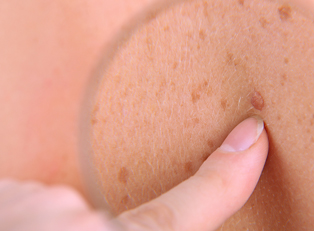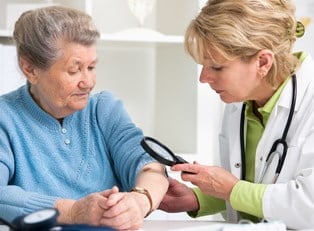Melanoma is one of the three primary types of skin cancer and is generally considered by medical professionals to be the most dangerous form. It develops in the cells that contain skin pigment, and is most commonly caused by an overexposure to ultraviolet rays, such as those produced by the sun or tanning beds. The chance of curing melanoma is high if it’s detected quickly, but that involves being aware of the warning signs associated with it. Here is a look at the most common symptoms caused by melanoma.
Early Signs of Melanoma
The best way to detect the early warning signs of melanoma is to be on the lookout for any unusual changes to your skin. New spots or moles that appear in adulthood as well as pre-existing spots that change size, shape, or color are both indicators that melanoma is developing or that you may be at risk for it.
These unusual changes can occur anywhere on your body, but they are most commonly found on areas that receive more exposure to the sun than most—including the face, arms, legs, and back. However, it’s important to realize that melanoma is not limited to these places. Some people, especially those with darker skin, also develop spots on the bottoms of the feet, the palms of the hand, or underneath the fingernails.
Examining Unusual Spots
Luckily, not all unusual spots on the skin indicate melanoma. In fact, medical experts have developed an easy pneumonic device for remembering how to assess a potentially cancerous mole or other blemish—ABCDE.
- A stands for asymmetry: A mole is potentially a melanoma if its shape is not symmetrical. Granted, most moles won’t have sides that are 100% identical to one another, but the asymmetry of those that are particularly dangerous will be quite noticeable.
- B stands for border: Melanomas frequently will have borders that are not well-defined. This can manifest in several different ways. For one, a melanoma may have a jagged edge instead of a smoother, rounder appearance. Additionally, it may be difficult to determine where the edge of the mole ends and the rest of the skin begins.
- C stands for color: There is no one individual color that puts you at a higher risk for melanoma—healthy moles can be can be any shade of brown or black. However, moles that are multiple colors are potentially cancerous. Sometimes these moles will simply be a mix of both brown and black, but it’s also possible to find them with shades of white, pink, or even blue.
- D stands for diameter: Most melanomas are larger than 6mm in diameter, which is about the size of a pencil eraser. That’s not to say that smaller melanomas haven’t been diagnosed, but as a general rule they tend to be on the large side.
- E stands for evolving: As it was mentioned earlier, moles that change over time are a major warning sign of melanoma. These included changes to the size, shape, or color of the mole. Even if a mole appears to be shrinking, it’s best to have it examined by a doctor.
Less Common Signs of Melanoma
There are a few other less common signs of melanoma as well. These include moles that are sensitive to the touch, frequently itch, or seem to bleed spontaneously. Additionally, bruises that take longer than normal to heal may also actually be melanoma. However, these symptoms almost always occur in conjunction with the other ones described above. So, for example, a healthy looking mole that itches is not as much a cause for concern as one that itches and looks unusual in some way.




